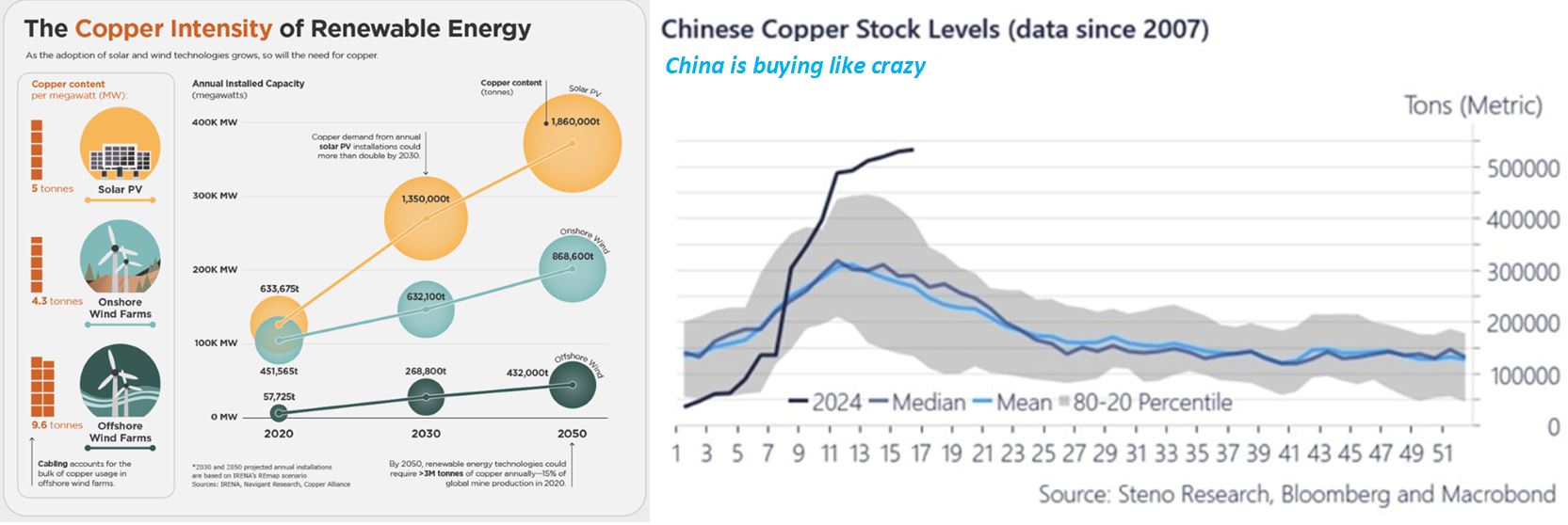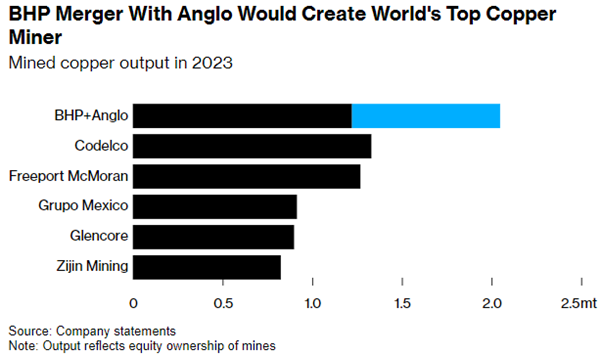AI adds to copper's perfect storm
I wrote an article in February 2023, about the looming shortage of Copper and while it has been a rough trade for 10 of the 14 months, a perfect storm is brewing and it's far worse than envisaged more than a year ago.
In that article, I cited the energy transition as my main cause for increased demand. On the supply side, the risks were geographical reliance on South America, record-low inventory levels, and slow mine development.
All of the supply risks are unfolding, much worse than anyone thought, but we now have a new catalyst for demand - AI and data centres - which will stretch the supply gap even wider in what could be a perfect storm for copper
Demand
Global copper demand is projected to hit 26 million tonnes in 2024. According to a Reuters survey, the copper market deficit is forecast to exceed 100,000 tonnes in 2025, compared to 35,000 tonnes this year. In my opinion, this is conservative with the rise of AI adding a new player to compete with the energy transition.
AI Demand
The rise of AI in the past 14 months has been incredible. In that time, the US market has conservatively added $3T in market cap due to AI, and the likes of Nvidia are up a whopping 400%. The consequence of this extreme spending on GPUs has led to a similar rise in data centre demand, with Nvidia’s GPU data centre sales up 409% in the last 12 months. More data centres means more copper, with 650,000 tonnes of copper needed per GW applied of power.

Nvidia's cutting-edge H100 AI GPUs are leading the way with energy consumption of over 13,000 GWh in the last year and growth over the next 2 years is expected to be around 40%. That’s around an extra 46,000 GWh in just two years, just for Nvidia.
Now, while existing infrastructure will handle much of the load, Chief Economist at Trafigura, Saad Rahim, said the copper demand stemming from data centres and AI has experienced a sudden and substantial surge. Rahim added the projected one million tonne increase adds to an existing deficit gap of four to five million tonnes expected by 2030.
The major AI players have serious influence with Amazon (NYSE: AMZN), Nvidia (NYSE: NVDA), Microsoft (NASDAQ: MSFT), Alphabet (NASDAQ: GOOGL), Meta (NASDAQ: META), Apple (NASDAQ: AAPL) and Tesla’s (NASDAQ: TSLA) combined market cap alone would make it the second-largest country stock exchange in the world, double that of Japan in fourth….. and they have piles of cash. Free cash flow has grown $100 billion in 2023, to $309 billion as of February 2024, and growth is needed to justify their current share price - so they won't let a little thing like copper get in their way.
The need for copper to expand the cloud and AI businesses of the Mag7 is not lost on Bill Gates and Jeff Bezos, who have joined BHP in backing a California-based metals exploration company, KoBold Metals, which recently found a large deposit in Zambia using artificial intelligence to create “Google Maps” of the Earth’s crust to help find new deposits of copper, lithium, cobalt and nickel.
So AI will just find us loads of copper, and problem solved - right? Not even close.
If this technology proves to be successful, it may help solve the problem within 15 years, the average length of time it takes to actually open a copper mine from discovery of the resource.
So what do we do in the meantime? From what is reflected in the supply numbers... pray.
Energy transition demand
When leaders signed on to the Paris Agreement, it was a great step in the right direction for the future of the planet. However, the politicians who agreed to it are likely to be long gone when their 2050 target rolls around and, as many broad-based policy decisions made on long-term projections, what is required is never predicted with any accuracy.
The share of global copper demand coming from “green” sectors including renewables and EVs is on course to double over the next 10 years, from about 8% to about 16%.
No matter the path we take to reduce carbon emissions, be it EV’s, renewables, nuclear, hydrogen… they all need copper
And
this is leading to big demand with China stockpiling and smelters in Asia hungry
for more, the copper concentrate market turned from surplus to deficit quicker
than expected.

Chart 2: Chinese stockpiling this year
This would not have been a concern if the energy transition was the only catalyst - we would have had more time, maybe recycled more - but with two hungry industries, we have a problem.
Supply
Even closing at a record high of $5 this week (18 May), the inflation-adjusted price of copper sits well below real peak prices in 2011. This has meant there has been little motivation for anyone to bother looking for more copper deposits, especially when the likes of superstar battery minerals lithium, graphite, nickel have all spiked significantly higher in the last five years.

Char 2: Copper discovery drought
This has led to global copper inventories being close to 30-year lows, in terms of days of demand. Without new significant supply coming on within at least two years, it makes prices far more sensitive to supply gaps. In recent months, we've seen more supply disappointments and disruptions than the market would like;
- Production at Codelco, the world's top supplier of the red metal, fell 10.1% to 107,300 metric tonnes in March.
- There was another strike at MMG's large Las Bambas copper mine, one of the largest copper mines in South America.
- Glencore's copper production fell another 2% last quarter and has been declining for more than four years.
- Copper production at Antofagasta, a major copper miner in Chile, was 129,400 tonnes in Q1 2024, 11% lower than in Q1 2023.
- Anglo-American lowered its 2024 output target for copper to between 730,000 tonnes and 790,000 tonnes, from as much as 1 million tonnes, essentially removing the equivalent of a large copper mine from global supply. Production will fall even further in 2025, before starting to rise again the following year.
- KGHM Group, a large copper miner from Poland, reported lower-than-planned copper production.
- One of the biggest supply disruptions was the government-ordered closure of one of the world's largest copper mines, First Quantum's Cobre Panama, which contributed over 330,000 tonnes of production in 2023.
This underscores the upside risk to the commodity price given the increased pricing power it gives producers.
How we are playing it
The obvious one in the Australian market is BHP Group (ASX: BHP). If they manage to purchase Anglo-American, they will be the world's top copper producer at over 2mt a year. Couple that with BHP’s other assets like uranium, iron ore and potash, they are well set up the for increased demand that will come from things we need over the next few decades.

The other is the ASX: WIRE ETF, which has some BHP in it, but also the other major global producers like First Quantum, Codelco, Glencore, Sandfire and Freeport McMoran
In the small-cap realm, we prefer Hillgrove Resources (ASX: HGO) which went into production in February, and Metals Acquisition CDI (ASX: MAC) which acquired Glencore's CSA mine in NSW which is the highest grade mine in Australia with 314kt reserves and 20kt production last year at a low AISC.
5 topics
11 stocks mentioned
1 fund mentioned

